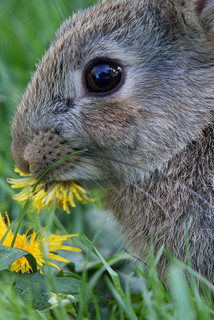Our garden is bursting with life at the moment! Busy, haggard birds are flitting around, building nest and laying eggs. Insect populations are slowly emerging and even our hens are getting broody! For the first year ever we have a number of young rabbits joining in the ecosystem that is our back garden. The rabbits in particular have attracted the children’s attention. You can understand why… there must be at least five of them and they are very tiny, very cute and very independent! That got my children wondering….
…”WHY ARE THEY OUT WITHOUT THEIR MAMMY?”
Rabbits are independent from a very early age. A female rabbit (called a Doe) will give birth to a litter of four to twelve baby rabbits (called Kits). The kits are born blind and without any fur. However within a week their eyes have opened, their fur begins to grow and their ears begin to stand upright. Wild rabbits will begin to wean about two weeks old and within three weeks they have grown enough to leave the nest and live independently. They may look small and helpless in our back garden but they are old enough to go it alone in the wild.
A doe can reach sexual maturity between three and six months and can live for up to ten years. The breeding season of rabbits usually last three quarters of the year. The most amazing aspect of the rabbit though, is that fact that the doe has no oestrus cycle. She can literally get pregnant a day after giving birth. Her gestation period is only one months long.
If you want to do the maths on all that it means that one doe could give birth to up 80 to 100 kits a year, or as many as 1,000 kits in one lifetime. With these turnover rates you can see why the kits have to be independent pretty quickly!
WHAT ABOUT BIRDS?

The busiest members of the garden seem to be the birds. Nest building, egg laying and then feeding a brood of hungry and demanding chicks. For the first part of their lives these chicks are completely dependent on their parents for food and the parents spend the early summer months on a non stop conveyor belt of foraging and feeding. The chicks learn to out “beg” their siblings rather than how to feed themselves. Of course this does not last for long, eventually these young birds will learn to fly and forage all by themselves … no mean feat!
Why do birds choose to feed rather than encourage foraging at an earlier stage? By evolving in this manner birds can choose to build their nests in more isolated, out of reach places, such as high up trees or on cliff edges. The compromise is that such places do not have a ready supply of food so the parents must go and source the food and bring it back. Although an exhausting process, the chicks are more likely to survive!
WHAT ABOUT THE INSECTS AND THEIR YOUNG?
This one depends on the insect obviously. Most insects’ parenting work ends with the lay of their eggs. This they usually do in large quantities, to increase the chances of survival of at least some of their progeny. Once the young hatch they are on their own! Often having to work their way through a number of different forms and changes before they even make it to adulthood! Imagine what it must be like to morph from a grub to an adult? Must be like going through your teens without any parental guidance what so ever!
Not all insects leave their young to their own devices of course. Some bee, wasp and ant species tend to the eggs in colonies of nests or hives. Once the larvae emerge from the egg they are fend and tended to completely, passing through different developmental stages until they pupate and emerge as adults.
HOW DO HUMAN INFANTS COMPARE?
The insects and birds mentioned above rely on their young doing most of their development outside the adult body, in eggs and/or larval stage. They are not mammals (giving birth to live young) like rabbits or humans. We have seen how quickly the rabbit young develop and gain independence from their mother. This is not the case with human infants though. So why the big difference between the dependence of the young in rabbits and humans?
Factors that influence the level of dependence of young on the adult can include…
- size of the fetus
- size of the mother
- number of young per birth
- brain size and growth rate
- cultural behaviour of the species
- life span
Rabbit have large litters, short gestation periods, a less developed brain and a shorter life span than humans. These facts all explain the difference in dependence of young.
If we look at all mammals we find that humans have very dependent young relative to most other species.It is thought that our evolution into bipedal (walks on two legs) creatures has meant that our young must be born with smaller brains and that the brain develops more after birth. This is for physical reasons: in order to walk upright the size of our pelvis is restricted and therefore the size of the infants we give birth to is restricted.
Scientists are now also looking at the contribution of maternal nurture and the cultural development of the society of the species. Humans have evolved a highly developed social and cultural environment. We have developed complex communication methods (e.g. language and social ques) and cultural interactions. In order to fit into such a complex system, perhaps the human infant must learn by observation and inclusion… neither of which it can do in the womb. Maybe we are born with such underdeveloped brains because most of our development and learning can only be done in the culture within which we will live!
What do you think?…..
